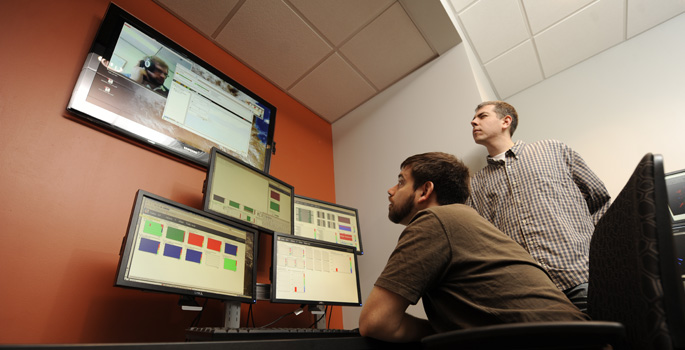
After the most complete search yet, the world’s largest atom smasher, the Large Hadron Collider (LHC) in Switzerland, reported that it has not found the much vaunted Higgs particle, ruling out a large portion of the energy range where it was most expected. The Higgs particle – also dubbed the “God particle” – is important because it may explain why some types of particles, like protons and neutrons, have mass while others, like photons, do not.
Vanderbilt has a small elementary particle physics group which is involved in this search as members of the science team that operates the CMS detector, the largest of six detectors at the LHC. At a group meeting last Thursday team members took some time to discuss what this announcement means.
The team members who participated were post doctoral fellow Alfredo Gurrola, who dialed in from College Park, Texas, Associate Professor of Physics Will E. Johns and graduate student Andrés Delannoy who connected from the LHC in Switzerland, graduate student Andrew Melo who participated from Fermi National Accelerator Laboratory near Chicago, and Physics Professor Paul Sheldon and Physics Professor Emeritus Med Webster who attended in person.

“This does not rule out the Higgs, it just limits further where it can be,” said Sheldon. “Most physicists would find it extremely interesting if we did not find the Higgs, but they also dread the headlines “5000 physicists fail to find Higgs after spending billions of dollars.” Headlines of this sort completely misunderstand the implications of the result and imply that we screwed up somehow, which would be totally false!”
Existence of the Higgs particle is predicted by the Standard Model, which is the favored mathematical theory that explains the behavior of subatomic particles. The latest analysis does not exclude the possibility that the Higgs particle exists in a lower mass form. “However, a low mass Higgs particle makes it less likely that the Standard Model can produce dark matter particles,” Gurrola said.
In addition, “the discovery of a low energy Standard Model Higgs would mean that there is not much else that we can find within energy levels that we can reach,” Johns added.

When the LHC was designed and approved, the world of high energy physics was much different from what it is today. Physicists felt they had a pretty good understanding of the matter that fills the universe. There were just a few remaining questions that needed answering: one is the question of the origin of mass and another was why the universe is filled with matter as we know it as opposed to its electrical opposite, antimatter, which theory says should have been produced in equal quantities.
Astronomers had just discovered “dark matter” – some kind of matter that is invisible to our telescopes but even more abundant than ordinary matter — but the physics community had just begun considering the implications. Then in 1998 evidence for the existence of “dark energy” – a repulsive force that is pushing the universe apart — was reported. Between them dark matter and energy appear to make up more than 95 percent of the universe. As a result, the type of matter that scientists have studied for centuries makes up less than 5 percent of the universe as a whole.
“The discovery of dark matter, in particular, has had a major impact on the particle physics community,” Webster commented. Although the mainstream response was to extend the Standard Model so that it produces a new class of dark matter particles, it has also inspired a number of other theories.
“Although the Standard Model Higgs is the most accepted one, there really is no good reason to prefer it over many other theories that address the origin of mass except for the fact that it is the simplest,” said Sheldon.
![Post Doctoral Fellow [CK] Alfredo Gurrola](http://blogs.vanderbilt.edu/research/files/CMS-AGurrola-234x300.jpg)
For example, there are theories of extra dimensions without Higgs particles that can explain both the mass problem and the recent controversial observation of neutrinos that travel faster than the speed of light, Gurrola said. “Physicists have tended to disregard these theories because they have strange implications for causality, but they would lead to a completely new sector of physics once thought to be purely science fiction.”